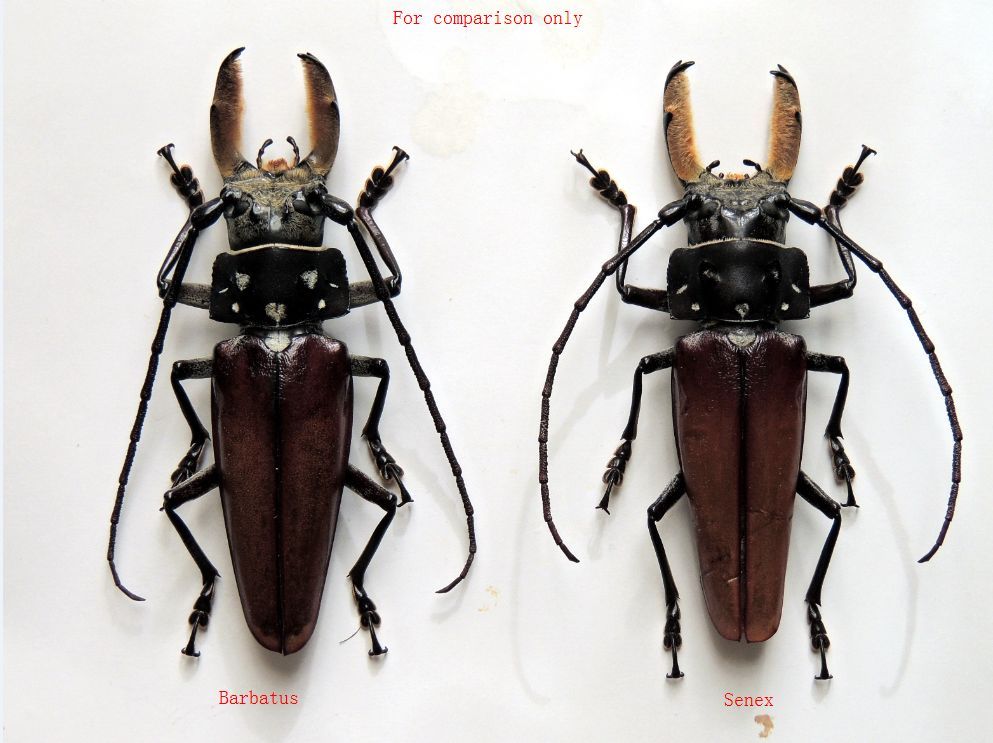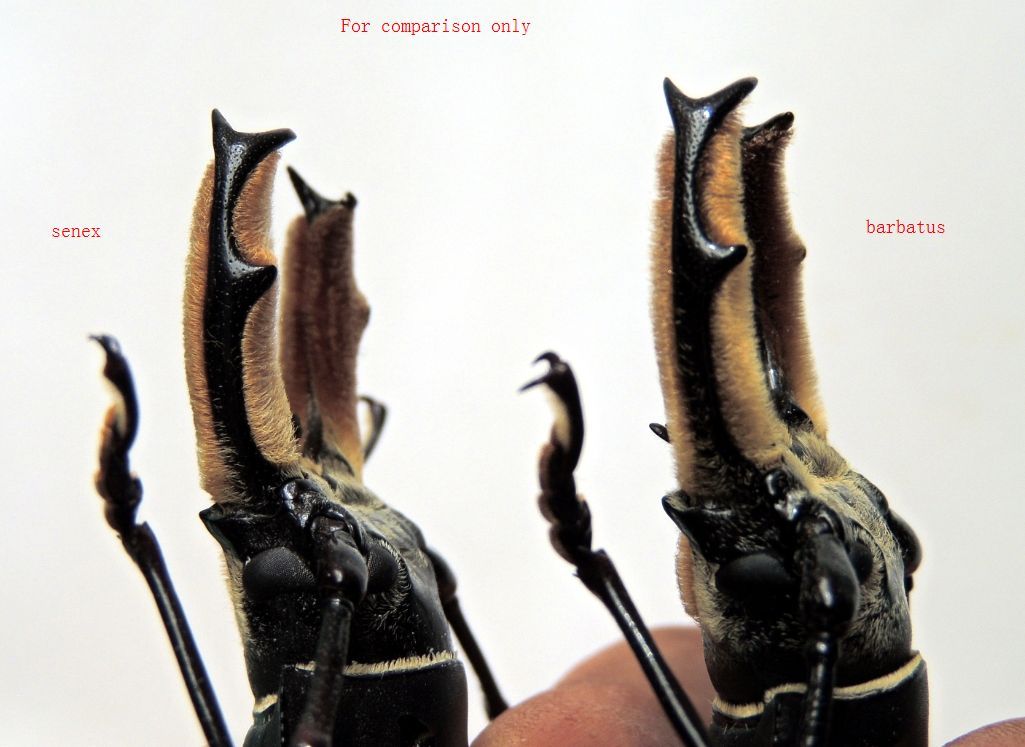| Author |
 Topic Topic  |
|
Pierre
Member Rosenbergia
   
Switzerland
1745 Posts |
 Posted - 20/04/2015 : 21:40:29 Posted - 20/04/2015 : 21:40:29



|
Can someone explain me how to separate the three mexican species of Callipogon: barbatus Fabricius, 1781, beckeri Lameere, 1904, and senex Dupont, 1832??
I have been trying to understand this mystery since years but never could find the key to the problem. Sometimes, I tend to think that these three names concern one single species... |
Edited by - Capitaine on 27/01/2016 17:32:24 |
|
|
dryobius
Member Rosenbergia
   
USA
1885 Posts |
 Posted - 21/04/2015 : 03:17:37 Posted - 21/04/2015 : 03:17:37



|
You're right Pierre.
Santos-Silva says that a revision is required. But being able to study the types is a challenge. |
 |
|
|
Capitaine
Scientific Collaborator
   
France
1833 Posts |
 Posted - 23/04/2015 : 14:06:28 Posted - 23/04/2015 : 14:06:28



|
That's right Pierre, it would be necessary to find the original type description of these species in order to enhance some criteria which could help in the differentiation (providing that such criteria exist !). In addition, considering the priones habitus variability, it could be better to compare specimens of similar size.
I'm not far to think that C. senex could be put in synonymy with C. barbatus (which is the type for the genus), and I haven't any element to consider C. beckeri as a good species...
I'll accurately check all my specimens in coll. to try to find complementary answer... |
Claude |
 |
|
|
dryobius
Member Rosenbergia
   
USA
1885 Posts |
 Posted - 24/04/2015 : 03:32:39 Posted - 24/04/2015 : 03:32:39



|
A colleague who passed away many years ago told me that it might be possible to separate C. barbatum from C. senex by the teeth on the inside of the mandible. But those teeth are mostly obscured by dense pubescence, and I can't find any difference in their position.
At this time I think they are the same species, and I don't know any American collectors who strongly disagree with me.
The pubescence on the elytra is variable. The size of the mandibles vary from specimen to specimen, which surely was considered by early entomologists to be significant, but we now know better.
This is an interesting discussion and perhaps some European collectors have more information. |
 |
|
|
Capitaine
Scientific Collaborator
   
France
1833 Posts |
 Posted - 24/04/2015 : 15:46:04 Posted - 24/04/2015 : 15:46:04



|
Trying to find some differences between these species I've taken pictures of ventral side of C. barbatus / senex male (left to right) and C. barbatus / senex / beckeri female.
I didn't find any character which could evidently separate barbatus and senex male (it seems that the height positioning of the median teeth on mandible is little different).
 
493.7 KB
Concerning females, barbatus and senex are very close, but beckeri has a ventral coloration quite different (reddish mat and not black bright). In addition, the prosternal apophyse has not the same shape and the gula looks different (less rounded).
That's need to be verified on several specimens (unfortunately, I don't own beckeri male in coll.)

502.92 KB |
Claude |
 |
|
|
Vitali
Member Rosalia
  
Estonia
991 Posts |
 Posted - 25/04/2015 : 11:24:14 Posted - 25/04/2015 : 11:24:14



|
May I ask how do you preserve your specimens in your collection? They do not seem to be pinned neither glued . . |
 |
|
|
Capitaine
Scientific Collaborator
   
France
1833 Posts |
 Posted - 26/04/2015 : 10:37:35 Posted - 26/04/2015 : 10:37:35



|
In fact, my specimens are pinned, but as I realize a catalogue issue
(by tribes) of priones, and in order to improve the presentation, the pin is rub out with a photographic software. |
Claude |
 |
|
|
Malpertuis
Member Purpuricenus
 
Belgium
108 Posts |
 Posted - 01/11/2016 : 08:42:47 Posted - 01/11/2016 : 08:42:47




|
| On dirait sur ces photos (par ailleurs super) que les ombres sont provoquées artificiellement ! Ce n'est pas une critique mais pour moi qui m'évertue à les éviter autant que possible... |
World Wide Beetles |
Edited by - Malpertuis on 01/11/2016 08:45:06 |
 |
|
|
Capitaine
Scientific Collaborator
   
France
1833 Posts |
 Posted - 01/11/2016 : 10:15:43 Posted - 01/11/2016 : 10:15:43



|
| Bonjour Noël, en fait ces photos sont prises en lumière naturelle sur plaque blanche sans suppression des ombres avec photoshop par exemple (sauf pour les 2 premiers à gauche). |
Claude |
 |
|
|
Malpertuis
Member Purpuricenus
 
Belgium
108 Posts |
 Posted - 01/11/2016 : 11:11:05 Posted - 01/11/2016 : 11:11:05




|
Ben je n'avais jamais vu des ombres aussi nettes, surtout en lumière naturelle. Pour ma part je préfère écarter le sujet du fond pour éviter les ombres portées qui peuvent contrarier la lecture de détails (de pilosité par exemple). J'utilise souvent aussi un fond gris +/- foncé qui les fait mieux ressortir. Surtout sur mes planches et gros plans sur ma galerie flickr mais c'est peu utilisé pour les photos de publications.
Rien de neuf pour la séparation de ces trois "espèces" ? |
World Wide Beetles |
Edited by - Malpertuis on 01/11/2016 11:17:58 |
 |
|
|
Capitaine
Scientific Collaborator
   
France
1833 Posts |
 Posted - 01/11/2016 : 15:11:03 Posted - 01/11/2016 : 15:11:03



|
La netteté vient du fait que la photo est réalisé sous la lumière solaire directe.
Mes photos de vue dorsales sont toujours présentées sans ombres portées mais je ne retouche pas les vues ventrales qui sont "optionnelles".
Concernant la séparation de ces espèces je n'ai malheureusement pas de références convaincantes pour le moment... |
Claude |
 |
|
|
Pierre
Member Rosenbergia
   
Switzerland
1745 Posts |
 Posted - 08/12/2016 : 13:12:54 Posted - 08/12/2016 : 13:12:54



|
I come back to the topic with these pictures found on ebay (the seller offers "C. senex"). - Honestly they don't make me wiser than before.

96.5 KB

109.3 KB

84.43 KB |
 |
|
|
Capitaine
Scientific Collaborator
   
France
1833 Posts |
 Posted - 08/12/2016 : 16:55:50 Posted - 08/12/2016 : 16:55:50



|
Hello Pierre, if the seller offered these specimens as "C.senex" how did you managed to separate the left one as C. barbatus ?
In any case, without fresh pilosity, it's very hard to find any characters discrepancy.
In my opinion, the right means to separate the two (maybe three with beckeri) species could be the barecoding made on several fresh specimens in order to highlight the pertinent characters after result. |
Claude |
 |
|
|
Francesco
Forum Admin
    
Luxembourg
9402 Posts |
 Posted - 08/12/2016 : 17:19:40 Posted - 08/12/2016 : 17:19:40




|
The bar-coding is a possibility, but we have never to forget that it can only prove that two taxa are different, never that two taxa are the same.
Moreover, it could also not working for this group, as e.g. in Aegosomatini. |
 |
|
|
Pierre
Member Rosenbergia
   
Switzerland
1745 Posts |
 Posted - 08/12/2016 : 17:47:20 Posted - 08/12/2016 : 17:47:20



|
Claude,
I just copied the photos such as they appear on ebay. The names "barbatus" and "senex" are written by the seller... |
 |
|
|
Capitaine
Scientific Collaborator
   
France
1833 Posts |
 Posted - 09/12/2016 : 17:38:23 Posted - 09/12/2016 : 17:38:23



|
Bonjour Francesco,
je ne suis pas un expert dans la technique du Barcoding adn, je sais qu'il est extrait du génome mitochondrial (dans un enzyme de la fonction respiratoire) et j'ai déjà vu des exemples de résultat sur des papillons.
Je suis étonné que deux individus de même espèce puissent avoir un résultat différent !?, et que veux tu dire par e.g. dans les Aegosomatini ? merci de m'apporter quelques précisions. |
Claude |
 |
|
 Topic Topic  |
|


